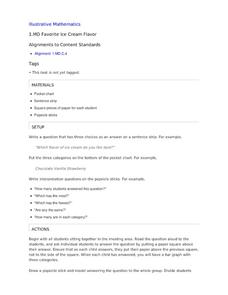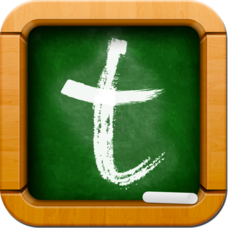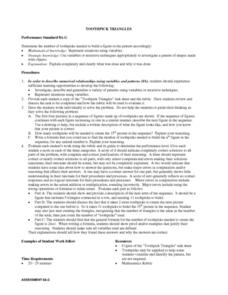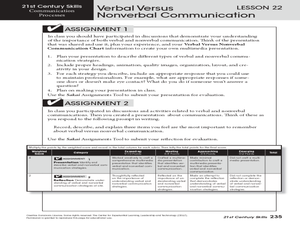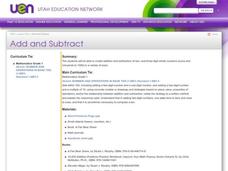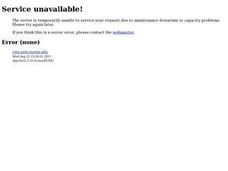Curated OER
Identifying Setting: Expository Writing
Your class can take turns describing a well know location or setting without giving its name, and the rest of the class can try to identify the location, based on the details given. They chart the elements that helped in the...
EduGAINs
Understanding Viscosity through Investigation and Comparison of Fluids
Not all liquids are the same. Investigate the viscosity of different fluids with a series of activities designed for eighth grade science. As learners move through learning centers with different experiment setups, they determine...
Curated OER
Winter Olympics History Year by Year
Investigate the history of the Winter Olympic Games. After researching this event and compiling necessary statistics, pupils use a graphic organizer to chart their findings. A template for a chart is included in this resource. Have your...
EngageNY
Interpreting, Integrating, and Sharing Information: Using Charts and Graphs about DDT
Is American growing fatter? Scholars begin with a mini lesson on reading charts and graphs using information about Human Body Fat in United States. They then transfer what they learned to charts and graphs using harmful and...
Curated OER
The Solar System - A Review
Students analyze their knowledge about the solar system. In this solar system review lesson, students look at a picture of the solar system on the SMART Board, name them in order, and are able to identify the sun as the center. They...
Curated OER
Time for Prime
Explore prime numbers. Learners use an interactive 100's chart to identify prime numbers, discuss a glossary of terms, use cards to list multiples of 2,3,4,5, and play a bingo game.
Illustrative Mathematics
Favorite Ice Cream Flavor
What better way to engage children in a math lesson than by talking about ice cream? Using a pocket chart or piece of chart paper, the class works together creating a bar graph of the their favorite ice cream flavors. Learners then work...
Monterey Bay Aquarium
What's in a Name?
Combine art and word analysis in a lesson about genus and species. Elementary children sleuth out the meaning of scientific names for a number of shark species using a prefix and suffix definition chart. They then draw an image of the...
Curated OER
Living and Non-Living Things
Take a walk and observe living and non-living things on the way. Young scientists practice making valuable observations and draw the details. You could require that your students complete a T chart of living and non-living things...
Curated OER
Acting Like a Third Grader (Part 1)
Third graders, after brainstorming the positive and negative types of behaviors, become aware of the right and wrong way to behave as a third grader. They perform a skit that demonstrates the skills and behaviors used by third grade...
ITWorx Egypt SAE
TeacherKit
Keep track of assignments, grades, attendance, seating, parent communication, behavior, and more with a one-stop classroom organization center.
Center for Civic Education
The Power of Nonviolence: What Is Nonviolence? What Does It Cost?
Your young learners will delve into the language of primary source documents in order to identify the characteristics, benefits, and costs of nonviolence. The lesson includes a mix of activities, including an anticipatory activity,...
Curated OER
Career Magic
Fifth graders gather information about the roles, responsibilities, skills, and training and education requirements of workers. Then they input this information into a graphic organizer chart and identify the similarities and differences...
Curated OER
Writing Lesson Plan: Homework Books
What a way to end the day! Class members recall important events that occurred throughout day. These events are posted on the chart board for class members to copy into their Homework Book. Books are sent home for parents to read, sign,...
Curated OER
George vs. George Essay Pre-writing
To practice pre-writing techniques your class will re-read the book George vs. George and complete a T-chart along with brainstorming ideas on how to organize their essay.
Curated OER
Toothpick Triangles
Learners draw a chart (included in the lesson) to use with their investigation. They review terminology of triangles and receive toothpicks to use in the lesson. Beginning with three toothpicks, students form a triangle. They complete...
Curated OER
Life Cycle of a Monarch Butterfly
Students identify the stage of the butterfly's life cycle. In this life cycles lesson, students create a KWL chart about monarch butterflies. Students observe monarch caterpillars in an aquarium and identify the various stages of growth.
Curated OER
You Be the Editor
Young editors work in teams to find all the errors in a text. They identify grammar, punctuation, and spelling errors. Use this activity to reinforce correct usage of prominent punctuation symbols, such as apostrophes and ellipses. You...
Curated OER
Verbal Versus Nonverbal Communication
Young scholars create a multimedia presentation. They will complete a verbal versus non-verbal communication chart to create a multimedia presentation which will include the different types of communication strategies. Then answer a...
Curated OER
The Coin and the Fable: Alaska quarter reverse
An Alaskan quarter and a book of fables is what you'll need to start this lesson. Learners will use the image of the bear and the salmon found on the reverse side of the Alaskan quarter as inspiration. They will compose a fable about the...
Curated OER
Add and Subtract
Like the cubs in A Fair Bear to Share, your 2nd grade class will practice adding and subtracting double-digit numbers by grouping, regrouping, and sorting a collection of objects. This requires many resources, but it is well worth the...
Curated OER
Applying KWL Guides to Sources with Elementary Students
What is a KWL chart? Here is a well thought-out activity that has learners use KWL charts to gain historical perspective. Your class examines primary sources about historical events and identifies what they know, want to know, and,...
Curated OER
THE GULF STREAM
Students explore how to describe the Gulf Stream, how Benjamin Franklin charted it, and correctly plot it on a map.
Curated OER
Stir Up a Character Analysis Recipe
What ingredients make up a character? A cup of honesty, a dash of humor, a pinch of cynicism? Based on real cookbooks they review in class, learners at any grade level three and up write recipes to describe characters familiar to your...






